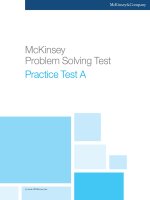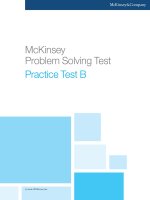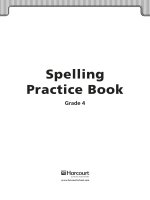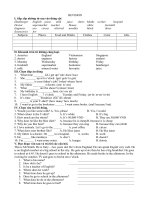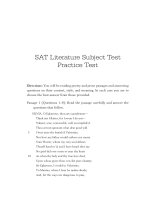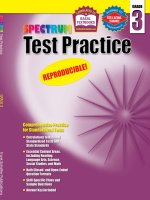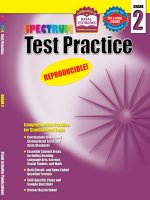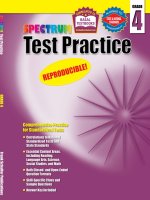Physics Test Practice Book
Bạn đang xem bản rút gọn của tài liệu. Xem và tải ngay bản đầy đủ của tài liệu tại đây (2.86 MB, 77 trang )
GRADUATE RECORD EXAMINATIONS
®
Physics Test
Practice Book
This practice book contains
Ⅲ one actual full-length GRE Physics Test
Ⅲ test-taking strategies
Become familiar with
Ⅲ test structure and content
Ⅲ test instructions and answering procedures
Compare your practice test results with the performance of those who
took the test at a GRE administration.
Visit GRE Online at www.gre.org
Listening.
Learning.
Leading.
This book is provided FREE with test registration by the Graduate Record Examinations Board.
Note to Test Takers: Keep this practice book until you receive your score report.
The book contains important information about content specifications and scoring.
Copyright ᮊ 2004 by Educational Testing Service. All rights reserved.
EDUCATIONAL TESTING SERVICE, ETS, the ETS logos, GRADUATE RECORD EXAMINATIONS,
and GRE are registered trademarks of Educational Testing Service.
Table of Contents
Purpose of the GRE Subject Tests ............................ 3
Development of the Subject Tests............................ 3
Content of the Physics Test ..................................... 4
Preparing for a Subject Test...................................... 5
Test-Taking Strategies .............................................. 6
What Your Scores Mean ........................................... 6
Practice Physics Test ................................................. 9
Scoring Your Subject Test ...................................... 71
Evaluating Your Performance ................................. 74
Answer Sheet ......................................................... 75
Purpose of the GRE
Subject Tests
The GRE Subject Tests are designed to help graduate
school admission committees and fellowship sponsors
assess the qualifications of applicants in specific fields
of study. The tests also provide you with an assessment
of your own qualifications.
Scores on the tests are intended to indicate knowledge of the subject matter emphasized in many undergraduate programs as preparation for graduate study.
Because past achievement is usually a good indicator of
future performance, the scores are helpful in predicting
success in graduate study. Because the tests are standardized, the test scores permit comparison of students
from different institutions with different undergraduate
programs. For some Subject Tests, subscores are provided in addition to the total score; these subscores
indicate the strengths and weaknesses of your preparation, and they may help you plan future studies.
The GRE Board recommends that scores on the
Subject Tests be considered in conjunction with other
relevant information about applicants. Because numerous factors influence success in graduate school,
reliance on a single measure to predict success is not
advisable. Other indicators of competence typically
include undergraduate transcripts showing courses
taken and grades earned, letters of recommendation,
the GRE Writing Assessment score, and GRE General
Test scores. For information about the appropriate use
of GRE scores, write to GRE Program, Educational
Testing Service, Mail Stop 57-L, Princeton, NJ 08541,
or visit our Web site at www.gre.org/codelst.html.
Development of the
Subject Tests
Each new edition of a Subject Test is developed by a
committee of examiners composed of professors in the
subject who are on undergraduate and graduate faculties in different types of institutions and in different
regions of the United States and Canada. In selecting
members for each committee, the GRE Program seeks
the advice of the appropriate professional associations
in the subject.
The content and scope of each test are specified
and reviewed periodically by the committee of examiners. Test questions are written by the committee and by
other faculty who are also subject-matter specialists
and by subject-matter specialists at ETS. All questions
proposed for the test are reviewed by the committee
and revised as necessary. The accepted questions are
assembled into a test in accordance with the content
specifications developed by the committee to ensure
adequate coverage of the various aspects of the field
and, at the same time, to prevent overemphasis on any
single topic. The entire test is then reviewed and
approved by the committee.
Subject-matter and measurement specialists on the
ETS staff assist the committee, providing information
and advice about methods of test construction and
helping to prepare the questions and assemble the test.
In addition, each test question is reviewed to eliminate
language, symbols, or content considered potentially
offensive, inappropriate for major subgroups of the testtaking population, or likely to perpetuate any negative
attitude that may be conveyed to these subgroups. The
test as a whole is also reviewed to ensure that the test
questions, where applicable, include an appropriate
balance of people in different groups and different roles.
Because of the diversity of undergraduate curricula,
it is not possible for a single test to cover all the
material you may have studied. The examiners,
PHYSICS TEST
PRACTICE BOOK
3
therefore, select questions that test the basic knowledge and skills most important for successful graduate
study in the particular field. The committee keeps the
test up-to-date by regularly developing new editions
and revising existing editions. In this way, the test
content changes steadily but gradually, much like most
curricula. In addition, curriculum surveys are conducted
periodically to ensure that the content of a test
reflects what is currently being taught in the undergraduate curriculum.
After a new edition of a Subject Test is first administered, examinees’ responses to each test question are
analyzed in a variety of ways to determine whether
each question functioned as expected. These analyses
may reveal that a question is ambiguous, requires
knowledge beyond the scope of the test, or is inappropriate for the total group or a particular subgroup of
examinees taking the test. Answers to such questions
are not used in computing scores.
Following this analysis, the new test edition is
equated to an existing test edition. In the equating
process, statistical methods are used to assess the
difficulty of the new test. Then scores are adjusted so
that examinees who took a difficult edition of the test
are not penalized, and examinees who took an easier
edition of the test do not have an advantage. Variations in the number of questions in the different
editions of the test are also taken into account in
this process.
Scores on the Subject Tests are reported as three
digit scaled scores with the third digit always zero.
The maximum possible range for all Subject Test total
scores is from 200 to 990. The actual range of scores for
a particular Subject Test, however, may be smaller. The
maximum possible range of Subject Test subscores is
20 to 99; however, the actual range of subscores for any
test or test edition may be smaller. Subject Test score
interpretive information is provided in Interpreting Your
GRE Scores, which you will receive with your GRE
score report, and on the GRE Web site at www.gre.org/
codelst.html.
The aim of the test is to determine the extent of
the examinees’ grasp of fundamental principles and
their ability to apply these principles in the solution
of problems. Most test questions can be answered on
the basis of a mastery of the first three years of undergraduate physics. The test questions are constructed
to simplify mathematical manipulations. As a result,
neither calculators nor tables of logarithms are needed.
If the solution to a problem requires the use of logarithms,
the necessary values are included with the question.
The International System (SI) of units is used
predominantly in the test. A table of information (see
page 10) representing various physical constants and a
few conversion factors among SI units is presented in
the test book. Whenever necessary, additional values
of physical constants are printed with the text of the
question.
The approximate percentages of the test on the
major content topics have been set by the committee
of examiners, with input from a nationwide survey of
undergraduate physics curricula. The percentages
reflect the committee’s determination of the relative
emphasis placed on each topic in a typical undergraduate program. These percentages are given below
along with the major subtopics included in each content
category. Nearly all the questions in the test will
relate to material in this listing; however, there may be
occasional questions on other topics not explicitly
listed here
1. CLASSICAL MECHANICS (such as
kinematics, Newton’s laws, work and
energy, oscillatory motion, rotational
motion about a fixed axis, dynamics of
systems of particles, central forces and
celestial mechanics, three-dimensional
particle dynamics, Lagrangian and
Hamiltonian formalism, noninertial
reference frames, elementary topics in
fluid dynamics)
Content of the Physics Test
The test consists of about 100 five-choice questions,
some of which may be grouped in sets and based on
such materials as diagrams, graphs, experimental data,
and descriptions of physical situations.
4
PHYSICS TEST
PRACTICE BOOK
20%
2. ELECTROMAGNETISM (such as
electrostatics, currents and DC
circuits, magnetic fields in free space,
Lorentz force, induction, Maxwell’s
equations and their applications,
electromagnetic waves, AC circuits,
magnetic and electric fields in matter)
3. OPTICS AND WAVE PHENOMENA
(such as wave properties, superposition,
interference, diffraction,
geometrical optics, polarization,
Doppler effect)
9. SPECIALIZED TOPICS: Nuclear
9%
and Particle physics (e.g., nuclear
properties, radioactive decay, fission
and fusion, reactions, fundamental
properties of elementary particles),
Condensed Matter (e.g., crystal
structure, x-ray diffraction, thermal
properties, electron theory of metals,
semiconductors, superconductors),
Miscellaneous (e.g., astrophysics, mathematical methods, computer applications)
18%
9%
4. THERMODYNAMICS AND STATISTICAL MECHANICS (such as
the laws of thermodynamics, thermodynamic processes, equations of state,
ideal gases, kinetic theory, ensembles,
statistical concepts and calculation of
thermodynamic quantities, thermal
expansion and heat transfer)
10%
5. QUANTUM MECHANICS (such as
fundamental concepts, solutions of
the Schrödinger equation (including
square wells, harmonic oscillators,
and hydrogenic atoms), spin, angular
momentum, wave function symmetry,
elementary perturbation theory)
12%
6. ATOMIC PHYSICS (such as properties of electrons, Bohr model, energy
quantization, atomic structure, atomic
spectra, selection rules, black-body
radiation, x-rays, atoms in electric and
magnetic fields)
10%
7. SPECIAL RELATIVITY (such as
introductory concepts, time dilation,
length contraction, simultaneity,
energy and momentum, four-vectors
and Lorentz transformation,
velocity addition)
6%
8. LABORATORY METHODS (such as
data and error analysis, electronics,
instrumentation, radiation detection,
counting statistics, interaction of
charged particles with matter, lasers
and optical interferometers, dimensional
analysis, fundamental applications
of probability and statistics)
6%
Those taking the test should be familiar with
certain mathematical methods and their applications
in physics. Such mathematical methods include single
and multivariate calculus, coordinate systems (rectangular, cylindrical, and spherical), vector algebra and
vector differential operators, Fourier series, partial
differential equations, boundary value problems,
matrices and determinants, and functions of complex
variables. These methods may appear in the test in the
context of various content categories as well as occasional questions concerning only mathematics in the
specialized topics category above.
Preparing for a Subject Test
GRE Subject Test questions are designed to measure
skills and knowledge gained over a long period of time.
Although you might increase your scores to some
extent through preparation a few weeks or months
before you take the test, last-minute cramming is
unlikely to be of further help. The following information may be helpful.
Ⅵ
A general review of your college courses is
probably the best preparation for the test. However, the test covers a broad range of subject
matter, and no one is expected to be familiar
with the content of every question.
Ⅵ
Use this practice book to become familiar
with the types of questions in the GRE Physics
Test, paying special attention to the directions. If
you thoroughly understand the directions before
you take the test, you will have more time during
the test to focus on the questions themselves.
PHYSICS TEST
PRACTICE BOOK
5
Test-Taking Strategies
What Your Scores Mean
The questions in the practice test in this book illustrate the types of multiple-choice questions in the test.
When you take the test, you will mark your answers on
a separate machine-scorable answer sheet. Total testing
time is two hours and fifty minutes; there are no
separately timed sections. Following are some general
test-taking strategies you may want to consider.
Your raw score — that is, the number of questions you
answered correctly minus one-fourth of the number
you answered incorrectly — is converted to the scaled
score that is reported. This conversion ensures that a
scaled score reported for any edition of a Subject Test
is comparable to the same scaled score earned on any
other edition of the same test. Thus, equal scaled
scores on a particular Subject Test indicate essentially
equal levels of performance regardless of the test
edition taken. Test scores should be compared only
with other scores on the same Subject Test. (For
example, a 680 on the Computer Science Test is not
equivalent to a 680 on the Mathematics Test.)
Before taking the test, you may find it useful to
know approximately what raw scores would be required
to obtain a certain scaled score. Several factors influence the conversion of your raw score to your scaled
score, such as the difficulty of the test edition and the
number of test questions included in the computation
of your raw score. Based on recent editions of the
Physics Test, the table on the next page gives the range
of raw scores associated with selected scaled scores for
three different test editions. (Note that when the
number of scored questions for a given test is greater
than the number of possible scaled scores, it is likely that
two or more raw scores will convert to the same scaled
score.) The three test editions in the table that follows
were selected to reflect varying degrees of difficulty.
Examinees should note that future test editions may be
somewhat more or less difficult than the test editions
illustrated in the table.
Ⅲ Read the test directions carefully, and work as
rapidly as you can without being careless. For
each question, choose the best answer from the
available options.
Ⅲ All questions are of equal value; do not waste
time pondering individual questions you find
extremely difficult or unfamiliar.
Ⅲ You may want to work through the test quite
rapidly, first answering only the questions about
which you feel confident, then going back and
answering questions that require more thought,
and concluding with the most difficult questions
if there is time.
Ⅲ If you decide to change an answer, make sure you
completely erase it and fill in the oval corresponding to your desired answer.
Ⅲ Questions for which you mark no answer or more
than one answer are not counted in scoring.
Ⅲ As a correction for haphazard guessing, onefourth of the number of questions you answer
incorrectly is subtracted from the number of
questions you answer correctly. It is improbable
that mere guessing will improve your score
significantly; it may even lower your score.
If, however, you are not certain of the correct
answer but have some knowledge of the question
and are able to eliminate one or more of the
answer choices, your chance of getting the right
answer is improved, and it may be to your advantage to answer the question.
Ⅲ Record all answers on your answer sheet.
Answers recorded in your test book will not
be counted.
Ⅲ Do not wait until the last five minutes of a
testing session to record answers on your
answer sheet.
6
PHYSICS TEST
PRACTICE BOOK
Range of Raw Scores* Needed to Earn
Selected Scaled Scores on Three
Physics Test Editions That
Differ in Difficulty
Scaled Score
900
800
700
600
Form A
73
58-59
44
30
Raw Scores
Form B
68-69
54-55
41
27
Form C
64
50
38
27
Number of Questions Used to Compute Raw Score
100
98
100
*Raw Score = Number of correct answers minus one-fourth the
number of incorrect answers, rounded to the nearest integer
For a particular test edition, there are many ways to
earn the same raw score. For example, on the edition
listed above as “Form A,” a raw score of 44 would earn
a scaled score of 700. Below are a few of the possible
ways in which a scaled score of 700 could be earned on
that edition.
Examples of Ways to Earn
a Scaled Score of 700 on the
Edition Labeled As “Form A”
Questions
Answered
Raw Score Correctly
44
44
44
49
44
55
Number of
Questions Questions Questions Used
Answered
Not
to Compute
Incorrectly Answered Raw Score
0
56
100
20
31
100
44
1
100
PHYSICS TEST
PRACTICE BOOK
7
Practice Test
To become familiar with how the administration will be conducted at the test center, first remove the
answer sheet (pages 75 and 76). Then go to the back cover of the test book (page 70) and follow the
instructions for completing the identification areas of the answer sheet. When you are ready to begin the
test, note the time and begin marking your answers on the answer sheet.
8
PHYSICS TEST
PRACTICE BOOK
FORM GR0177
77
GRADUATE RECORD EXAMINATIONS®
PHYSICS TEST
Do not break the seal
until you are told to do so.
The contents of this test are confidential.
Disclosure or reproduction of any portion
of it is prohibited.
THIS TEST BOOK MUST NOT BE TAKEN FROM THE ROOM.
Copyright © 2001 by Educational Testing Service. All rights reserved.
GRE, GRADUATE RECORD EXAMINATIONS, ETS, EDUCATIONAL TESTING
SERVICE and the ETS logos are registered trademarks of Educational Testing Service.
9
TABLE OF INFORMATION
Rest mass of the electron
Magnitude of the electron charge
me = 9.11 × 10−31 kilogram = 9.11 × 10−28 gram
e = 1.60 × 10−19 coulomb = 4.80 × 10−10 statcoulomb (esu)
Avogadro’s number
NA = 6.02 × 1023 per mole
Universal gas constant
R = 8.31 joules/(mole ∑ K)
Boltzmann’s constant
Speed of light
Planck’s constant
k = 1.38 × 10−23 joule/K = 1.38 × 10−16 erg/K
c = 3.00 × 108 m/s = 3.00 × 1010 cm/s
h = 6.63 × 10−34 joule ∑ second = 4.14 × 10−15 eV ∑ second
j = h/2 p
Vacuum permittivity
Vacuum permeability
Universal gravitational constant
Acceleration due to gravity
1 atmosphere pressure
1 angstrom
⑀ 0 = 8.85 × 10−12 coulomb 2/(newton ∑ meter 2)
m 0 = 4 p × 10−7 weber/(ampere ∑ meter)
G = 6.67 × 10−11 meter 3/(kilogram ∑ second 2)
g = 9.80 m/s 2 = 980 cm/s 2
1 atm = 1.0 × 105 newtons/meter 2 = 1.0 × 105 pascals (Pa)
1Å = 1 × 10−10 meter
1 weber/m2 = 1 tesla = 10 4 gauss
Moments of inertia about center of mass
Rod
Disc
10
1
MR 2
2
Sphere
Unauthorized copying or reuse of
any part of this page is illegal.
1
M
12
2
MR 2
5
2
GO ON TO THE NEXT PAGE.
This test starts on page 12
Unauthorized copying or reuse of
any part of this page is illegal.
GO ON TO THE NEXT PAGE.
11
PHYSICS TEST
Time—170 minutes
100 Questions
Directions: Each of the questions or incomplete statements below is followed by five suggested answers or
completions. Select the one that is best in each case and then fill in the corresponding space on the answer sheet.
1. Which of the following best illustrates the
acceleration of a pendulum bob at points
a through e ?
(A)
2. The coefficient of static friction between a small
coin and the surface of a turntable is 0.30. The
turntable rotates at 33.3 revolutions per minute.
What is the maximum distance from the center
of the turntable at which the coin will not slide?
(A)
(B)
(C)
(D)
(E)
(B)
(C)
(D)
0.024 m
0.048 m
0.121 m
0.242 m
0.484 m
3. A satellite of mass m orbits a planet of mass M
in a circular orbit of radius R. The time required
for one revolution is
(A)
(B)
(C)
(D)
(E)
independent of
proportional to
linear in R
proportional to
proportional to
M
m
R3/2
R2
4. In a nonrelativistic, one-dimensional collision,
a particle of mass 2m collides with a particle of
mass m at rest. If the particles stick together after
the collision, what fraction of the initial kinetic
energy is lost in the collision?
(A) 0
(B)
12
1
3
1
2
(E)
Unauthorized copying or reuse of
any part of this page is illegal.
(C)
(D)
(E)
1
4
2
3
GO ON TO THE NEXT PAGE.
SCRATCHWORK
Unauthorized copying or reuse of
any part of this page is illegal.
GO ON TO THE NEXT PAGE.
13
5. A three-dimensional harmonic oscillator is in
thermal equilibrium with a temperature reservoir
at temperature T. The average total energy of the
oscillator is
(A)
1
kT
2
(B) kT
(C)
3
kT
2
(D) 3kT
(E) 6kT
6. An ideal monatomic gas expands quasi-statically
to twice its volume. If the process is isothermal,
the work done by the gas is Wi . If the process
is adiabatic, the work done by the gas is Wa .
Which of the following is true?
(A)
(B)
(C)
(D)
(E)
Wi = Wa
0 = Wi <
0 < Wi <
0 = Wa <
0 < Wa <
Wa
Wa
Wi
Wi
7. Two long, identical bar magnets are placed under
a horizontal piece of paper, as shown in the figure
above. The paper is covered with iron filings.
When the two north poles are a small distance
apart and touching the paper, the iron filings
move into a pattern that shows the magnetic field
lines. Which of the following best illustrates the
pattern that results?
(A)
(B)
(C)
(D)
(E)
Unauthorized copying or reuse of
any part of this page is illegal.
14
GO ON TO THE NEXT PAGE.
SCRATCHWORK
Unauthorized copying or reuse of
any part of this page is illegal.
GO ON TO THE NEXT PAGE.
15
8. A positive charge Q is located at a distance L
above an infinite grounded conducting plane,
as shown in the figure above. What is the total
charge induced on the plane?
(A)
(B)
(C)
(D)
(E)
2Q
Q
0
-Q
-2Q
11. An object is located 40 centimeters from the
first of two thin converging lenses of focal lengths
20 centimeters and 10 centimeters, respectively,
as shown in the figure above. The lenses are
separated by 30 centimeters. The final image
formed by the two-lens system is located
(A)
(B)
(C)
(D)
(E)
5.0 cm to the right of the second lens
13.3 cm to the right of the second lens
infinitely far to the right of the second lens
13.3 cm to the left of the second lens
100 cm to the left of the second lens
9. Five positive charges of magnitude q are
arranged symmetrically around the circumference
of a circle of radius r. What is the magnitude of
the electric field at the center of the circle?
( k = 1 4 p⑀0 )
(A) 0
(B) kq r 2
(C) 5kq r 2
a
f
(D) ( kq / r 2 ) cos 2 p / 5
2
a
f
(E) (5kq / r ) cos 2 p / 5
10. A 3-microfarad capacitor is connected in series
with a 6-microfarad capacitor. When a 300-volt
potential difference is applied across this combination, the total energy stored in the two
capacitors is
(A)
(B)
(C)
(D)
(E)
0.09 J
0.18 J
0.27 J
0.41 J
0.81 J
Unauthorized copying or reuse of
any part of this page is illegal.
16
12. A spherical, concave mirror is shown in the figure
above. The focal point F and the location of the
object O are indicated. At what point will the
image be located?
(A)
(B)
(C)
(D)
(E)
I
II
III
IV
V
GO ON TO THE NEXT PAGE.
SCRATCHWORK
Unauthorized copying or reuse of
any part of this page is illegal.
GO ON TO THE NEXT PAGE.
17
13. Two stars are separated by an angle of
3 ¥ 10-5 radians. What is the diameter of the
smallest telescope that can resolve the two stars
using visible light ( l @ 600 nanometers) ?
(Ignore any effects due to Earth’s atmosphere.)
(A) 1 mm
(B) 2.5 cm
(C) 10 cm
(D) 2.5 m
(E) 10 m
14. An 8-centimeter-diameter by 8-centimeter-long
NaI(Tl) detector detects gamma rays of a specific
energy from a point source of radioactivity. When
the source is placed just next to the detector at
the center of the circular face, 50 percent of all
emitted gamma rays at that energy are detected.
If the detector is moved to 1 meter away, the
fraction of detected gamma rays drops to
(A)
(B)
(C)
(D)
(E)
10-4
2 ¥ 10-4
4 ¥ 10-4
8p ¥ 10-4
16p ¥ 10-4
15. Five classes of students measure the height of a
building. Each class uses a different method and
each measures the height many different times.
The data for each class are plotted below. Which
class made the most precise measurement?
(A)
(B)
(C)
(D)
(E)
Unauthorized copying or reuse of
any part of this page is illegal.
18
GO ON TO THE NEXT PAGE.
SCRATCHWORK
Unauthorized copying or reuse of
any part of this page is illegal.
GO ON TO THE NEXT PAGE.
19
16. A student makes 10 one-second measurements
of the disintegration of a sample of a long-lived
radioactive isotope and obtains the following
values.
3, 0, 2, 1, 2, 4, 0, 1, 2, 5
How long should the student count to establish
the rate to an uncertainty of 1 percent?
(A)
80 s
(B) 160 s
(C) 2,000 s
(D) 5,000 s
(E) 6,400 s
17. The ground state electron configuration
for phosphorus, which has 15 electrons, is
(A) 1s2 2s2 2p6 3s1 3p4
(B) 1s2 2s2 2p6 3s2 3p3
(C) 1s2 2s2 2p6 3s2 3d3
(D) 1s2 2s2 2p6 3s1 3d4
(E) 1s2 2s2 2p6 3p2 3d3
18. The energy required to remove both electrons
from the helium atom in its ground state is
79.0 eV. How much energy is required to ionize
helium (i.e., to remove one electron) ?
(A)
(B)
(C)
(D)
(E)
24.6 eV
39.5 eV
51.8 eV
54.4 eV
65.4 eV
Unauthorized copying or reuse of
any part of this page is illegal.
20
19. The primary source of the Sun’s energy is a series
of thermonuclear reactions in which the energy
produced is c2 times the mass difference between
(A)
(B)
(C)
(D)
(E)
two hydrogen atoms and one helium atom
four hydrogen atoms and one helium atom
six hydrogen atoms and two helium atoms
three helium atoms and one carbon atom
two hydrogen atoms plus two helium atoms
and one carbon atom
20. In the production of X rays, the term
“bremsstrahlung” refers to which of the
following?
(A) The cut-off wavelength, lmin , of the
X-ray tube
(B) The discrete X-ray lines emitted when an
electron in an outer orbit fills a vacancy in
an inner orbit of the atoms in the target
metal of the X-ray tube
(C) The discrete X-ray lines absorbed when an
electron in an inner orbit fills a vacancy in
an outer orbit of the atoms in the target
metal of the X-ray tube
(D) The smooth, continuous X-ray spectra
produced by high-energy blackbody
radiation from the X-ray tube
(E) The smooth, continuous X-ray spectra
produced by rapidly decelerating electrons
in the target metal of the X-ray tube
21. In the hydrogen spectrum, the ratio of the
wavelengths for Lyman-a radiation (n = 2 to
n = 1) to Balmer-a radiation (n = 3 to n = 2) is
(A)
(B)
(C)
(D)
(E)
5/48
5/27
1/3
3
27/5
GO ON TO THE NEXT PAGE.
SCRATCHWORK
Unauthorized copying or reuse of
any part of this page is illegal.
GO ON TO THE NEXT PAGE.
-
21
22. An astronomer observes a very small moon
orbiting a planet and measures the moon’s
minimum and maximum distances from the
planet’s center and the moon’s maximum orbital
speed. Which of the following CANNOT be
calculated from these measurements?
(A)
(B)
(C)
(D)
(E)
Mass of the moon
Mass of the planet
Minimum speed of the moon
Period of the orbit
Semimajor axis of the orbit
Unauthorized copying or reuse of
any part of this page is illegal.
22
23. A particle is constrained to move in a circle with a
10-meter radius. At one instant, the particle’s
speed is 10 meters per second and is increasing at
a rate of 10 meters per second squared. The angle
between the particle’s velocity and acceleration
vectors is
(A)
(B)
(C)
(D)
(E)
0∞
30∞
45∞
60∞
90∞
GO ON TO THE NEXT PAGE.
SCRATCHWORK
Unauthorized copying or reuse of
any part of this page is illegal.
GO ON TO THE NEXT PAGE.
23
u
u
O
t
u
O
t
I
O
t
II
u
III
u
O
t
IV
O
t
V
24. A stone is thrown at an angle of 45° above the horizontal x-axis in the +x-direction. If air resistance is
ignored, which of the velocity versus time graphs shown above best represents u x versus t and u y versus t,
respectively?
ux vs. t
uy vs. t
(A)
(B)
(C)
(D)
(E)
I
II
II
II
IV
Unauthorized copying or reuse of
any part of this page is illegal.
24
IV
I
III
V
V
GO ON TO THE NEXT PAGE.
SCRATCHWORK
Unauthorized copying or reuse of
any part of this page is illegal.
GO ON TO THE NEXT PAGE.
25

